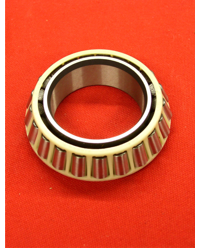Machine Vision Systems
Wood Product Inspection SystemsPrinting and Finish Inspection Systems
Metal Part Inspection Systems
Thread Analysis & Inspection Systems
Bearing Assembly Inspection Systems
Bearing Race Inspection Systems
Automotive Control Arm Inspection Systems
Manifold & Crossover Inspection Systems
Assembly Inspection Systems
Battery Inspection Systems
Tablet, Capsule and Pill Inspection Systems
Circuit Board Component Assembly Inspection Systems
Packaged Liquid Product Inspection Systems
Caps & Closures Inspection Systems
Gravity Belt Thickener Control
Ultra-Accurate Automatic Gauging Systems
Automatically inspects completed bearing assemblies to ensure the bearing is free from defects directly related to final assembly.
FyrEye-3230 systems inspect bearings after assembly for a wide range of defects including:
- Missing or misplaced bearings
- Cage and race damage during assembly
- Reversed orientation of components
- Incorrect components
- Improperly seated bearings
- Race out of round

FSI is capable of testing several different styles of bearings, including but not limited to:
- Ball bearings
- Roller bearings
- Taper roller bearings
- Thrust bearings
- Thrust roller bearings
- Needle bearings
- Ceramic bearings
The FyrEye-3230 is a family of systems, customized to your application and requirements. Your particular model will be from the same family, but will have different variations in equipment and capabilities. The FyrEye-3230-02 is an example; it includes:
- Engineered lighting specialized for high accuracy inspection performance.
- One camera with high resolution, progressive area scan imaging, plus sub-pixeling and model geometry tools to reduce error.
- CLTG series lens which combines high accuracy with telecentricity.
- Spreadsheet storage of numerical results.
- Ability to verify correct parts and part positioning in the assembly. Fulfills application and performance specification # VAS-3230-02 (copy available). Each application will have its own VAS (Vision Application Spec Sheet).
This system may be adapted to include:
- Dynamically and individually calibrated measurements.
- Image distortion-correction plug-ins which may not require high-accuracy telecentric lenses.
Please contact FSI for a system and solution that is confirmed for your application.
FSI has been a trusted factory automation manufacturer for over 50 years. Our Assured Path to Success™ methods and programs have a 100% success rate in this field
of machine vision. Because our engineers are deeply involved in understanding the application, recommending the products, and supporting the software, these
systems are uniquely suited for long term supportability and standardization.
For printable version
click here






